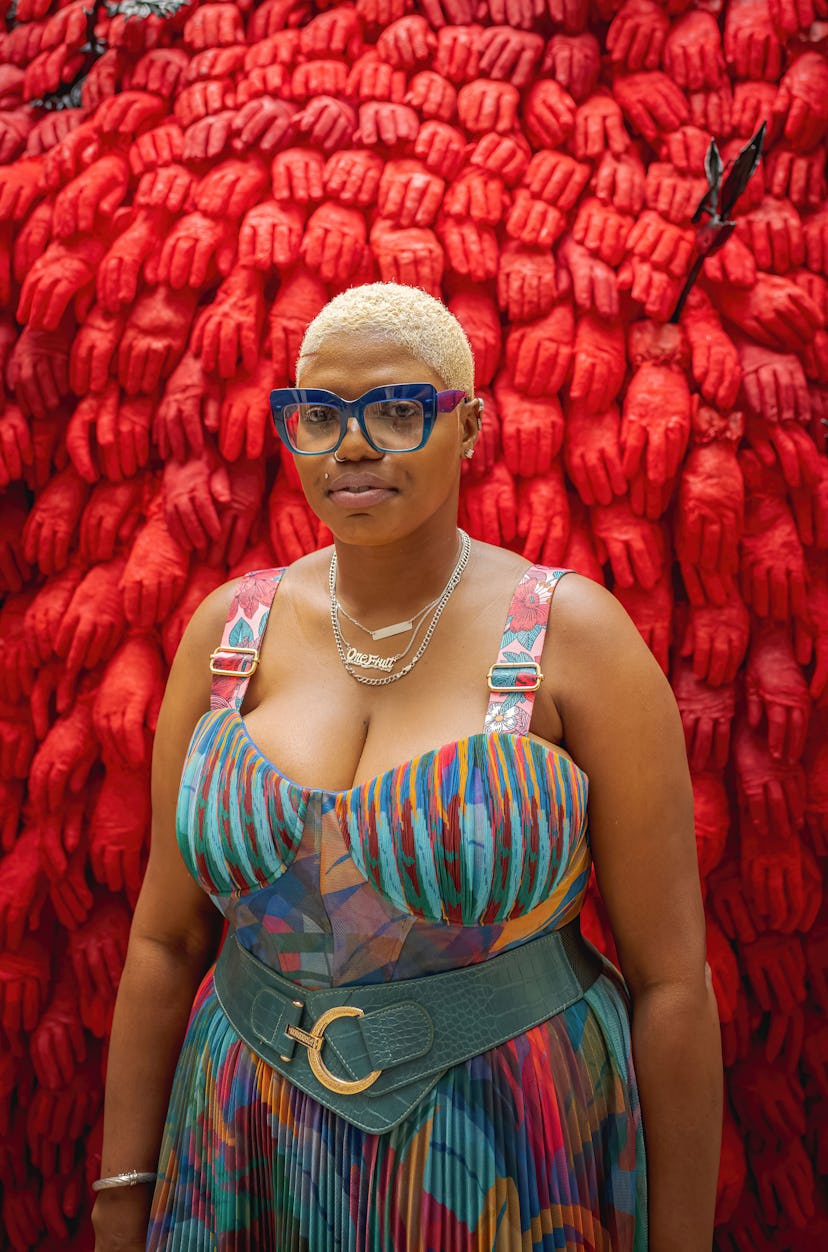Ebony G. Patterson Digs Into the New York Botanical Garden
The Jamaican artist has brought living plant installations, multimedia sculptures and a flock of glittering vultures to the Bronx institution.

Did you know that a flock of feeding vultures is called a “wake”?
I learned that fact thanks to the artist Ebony G .Patterson, who has just placed 400 larger-than-life sculptures of glittery black vultures in the New York Botanical Garden as part of her expansive new show “…things come to thrive…in the shedding…in the molting….”
The exhibition, on view through September 17, is split between two locales amidst the botanical garden’s 250 verdant acres. The vultures sit on a lawn that has been sliced into, like a wound, and filled with a tight palette of bruise-like red, black and purple flora. (Note, among the medicinal plants, the toxic ricin.) Patterson says she specifically worked with the gardens’s horticulture staff to include specimens that will die as summer heats up and directed that they be left to decay so as to regenerate the soil, and “so that the full cycle remains visible,” she says.
“I have a quote in my studio that says ‘Gardens are evidence of the rape of the world,’”
Patterson told Thelma Golden, the director and chief curator of The Studio Museum in Harlem, in a public talk on the eve of the exhibition’s opening. Patterson added: “So many of these plants that we love and adore came on the same ships that these Black bodies came on.”
The day before the opening Patterson sat in the library of the botanical garden, surrounded by titles like Plant Craft and The Ethnobotany Desk Reference. We talked first about the vultures, which are sure to be the Insta-stars of the show this summer, but which many people find revolting if not terrifying. “It is sad that vultures get a bad rap,” she told me. “They come as an act of love, of care.” They come to foster regeneration from what is dead—a key theme here. She likened the dreaded birds to “people who have to do the work we don’t want to do.”
Just weeks ago, Patterson, 42, won the David C. Driskell Prize in recognition of “field-defining contributions to African American art,” one of many triumphs that have come steadily since she earned her MFA from Washington University in St. Louis in 2004, following a degree in painting in Kingston, Jamaica, where she was born and raised. Her next major solo effort, which focuses on the female form, will open next June in the U.K. at Arnolfini, Bristol’s International Centre for Contemporary Arts. In the fall of next year is Patterson’s first major curatorial effort: the art triennial Prospect New Orleans’s sixth edition, which she is co-organizing (the first artist to do so) with the Museum of Contemporary Art Denver’s senior curator, Miranda Lash.
For now, Patterson’s work at the Botanical Gardens feels like the culmination of many of the themes she has explored throughout her career: how lurking just behind beauty is often a socio-political snarl around race, gender, class, violence and colonialism.
In an atrium, along a walkway as red and jagged as a fresh scar, nearly 200 sculptures crafted in ghostly white glass represent extinct species she discovered as in the garden’s nearby Herbarium during her time as a resident. She has also created human forms in various shades of that white glass. Together, those glass forms also perhaps serve as a criticism of the violence humans are continuing to cause through the climate crisis.
In the library is a video, just acquired by the Brooklyn museum, and a colossal new multimedia sculpture “…fester…” (2023) comprising decorous materials that have long been her trademark, as well as glass. It recalls the snarled roots of an ancient tree that has been downed by storm, exposing the secrets beneath. In a gallery are illustrated botany books showing the now-extinct species that inform much of the exhibition, alongside a 2022 series of three-dimensional, multimedia wall sculptures incorporating paper and plastic insects titled “studies for a vocabulary of loss.”
Even amidst the pointedness, Patterson’s work is also about “the potential for healing and rejuvenation,” as Jennifer Bernstein, the president and CEO of the New York Botanical Garden, put it. “It entices, it scorns, it provokes,” Bernstein said. “And we are really looking forward to the conversations it will lead to.”
The botanical garden has a long history of integrating visual art into its programs, but the staff at the gardens had not “worked with artists who considered plants as material,” Patterson said. In planning this project and thinking about the typical audience for a botanical garden, Patterson wondered, What it would mean to make the people “who would come just for the peonies just a little annoyed? We don’t want to think about traumas continuously, but I think it’s important to consider them sometimes.”
Gardens, like fashion, “are about embellishment,” she says. “But below all of that beauty, there are other complexities.” She points out that wealthy housing developments often pay special attention to the landscaping and enclosed private gardens, and often have names that camouflage the hidden labor and sometimes the socio-political violence of those spaces. She notes too that town dumps and the typically poor communicates around them are often given names like “Majestic Gardens” meant to mitigate their ugliness, though no one is so fooled.
Patterson is in good company in that horticulture has become, shall we say, fertile ground for Black artists in particular (Nigerian-American artist Precious Okoyomon, who creates living plant installations, comes to mind) to explore what and who is visible, invited, welcomed, cultivated, and what and who is considered hidden, undesirable, invasive and deserving of death, and by whom. Horticulture seems to demand a fascination with provenance, with breeding.
Some gardens, Patterson points out, are given “the possibility of care” while others not. But they may thrive anyway.
This article was originally published on